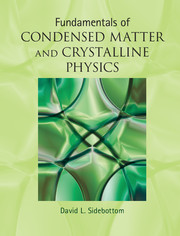 Fundamentals of Condensed Matter and Crystalline Physics
Fundamentals of Condensed Matter and Crystalline Physics from Part II - Scattering
Published online by Cambridge University Press: 05 August 2012
Introduction
In this final chapter on the subject of scattering, we examine the structure of extended, but finite-sized composite objects constructed of a very large number of individual particles. Examples include polymer molecules composed of many repeated individual chemical units, and aggregation clusters that form when many individual particles randomly assemble into a larger structure. In both instances, we will see that the amorphous structures of these macroscopic-sized objects display self-similarity – a continuous hierarchy of structures that appear identical on many alternative length scales. This self-similarity appears in the pair distribution function as a power law dependence on radial distance, much unlike the sort of g(r) curves we have examined thus far, and which transforms into Fourier space as a corresponding power law variation of S(q).
Also in this chapter, we conclude our survey of structures and scattering with a brief look at liquid crystals and microemulsions, whose structures undergo a series of transitions with symmetries that are intermediate between that of crystals and liquids. In these materials the particles are able to spontaneously self-assemble into more ordered structures as a result of only weak, inter-particle forces.
To save this book to your Kindle, first ensure [email protected] is added to your Approved Personal Document E-mail List under your Personal Document Settings on the Manage Your Content and Devices page of your Amazon account. Then enter the ‘name’ part of your Kindle email address below. Find out more about saving to your Kindle.
Note you can select to save to either the @free.kindle.com or @kindle.com variations. ‘@free.kindle.com’ emails are free but can only be saved to your device when it is connected to wi-fi. ‘@kindle.com’ emails can be delivered even when you are not connected to wi-fi, but note that service fees apply.
Find out more about the Kindle Personal Document Service.
To save content items to your account, please confirm that you agree to abide by our usage policies. If this is the first time you use this feature, you will be asked to authorise Cambridge Core to connect with your account. Find out more about saving content to Dropbox.
To save content items to your account, please confirm that you agree to abide by our usage policies. If this is the first time you use this feature, you will be asked to authorise Cambridge Core to connect with your account. Find out more about saving content to Google Drive.